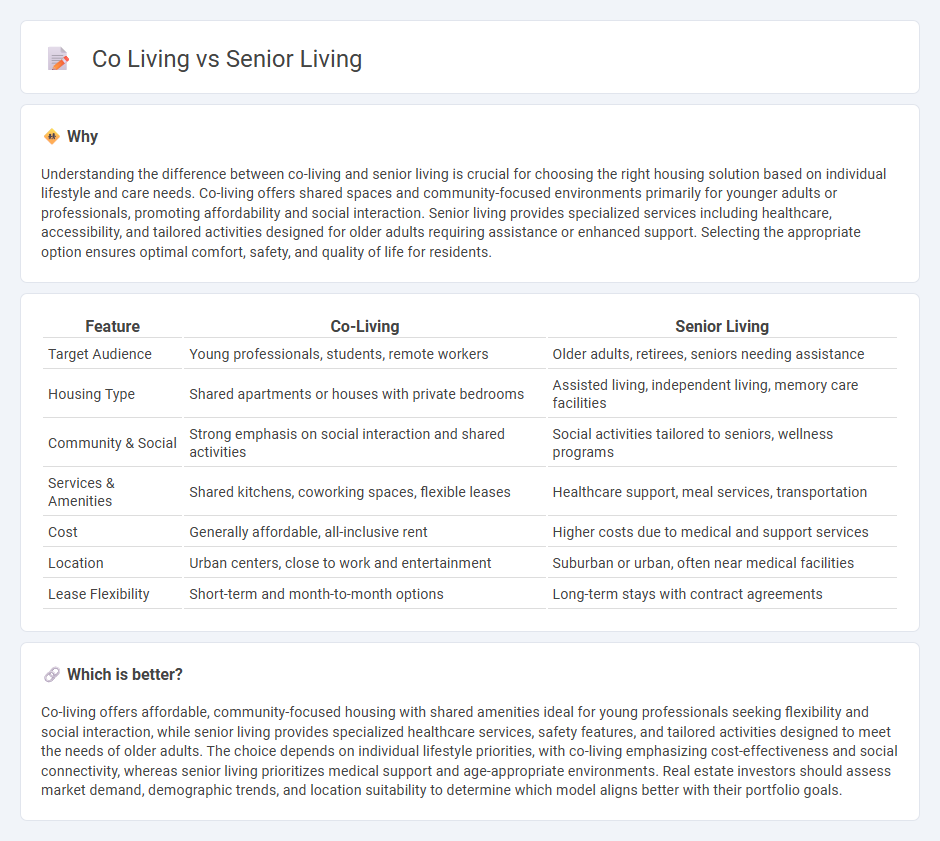
Co-living spaces offer flexible, community-oriented housing primarily designed for young professionals and students, emphasizing affordability and shared amenities. Senior living facilities focus on comfort and healthcare support tailored to older adults, featuring assisted living, independent living, and memory care options. Explore the key differences and benefits of co-living versus senior living to determine the best fit for lifestyle needs.
Why it is important
Understanding the difference between co-living and senior living is crucial for choosing the right housing solution based on individual lifestyle and care needs. Co-living offers shared spaces and community-focused environments primarily for younger adults or professionals, promoting affordability and social interaction. Senior living provides specialized services including healthcare, accessibility, and tailored activities designed for older adults requiring assistance or enhanced support. Selecting the appropriate option ensures optimal comfort, safety, and quality of life for residents.
Comparison Table
| Feature | Co-Living | Senior Living |
|---|---|---|
| Target Audience | Young professionals, students, remote workers | Older adults, retirees, seniors needing assistance |
| Housing Type | Shared apartments or houses with private bedrooms | Assisted living, independent living, memory care facilities |
| Community & Social | Strong emphasis on social interaction and shared activities | Social activities tailored to seniors, wellness programs |
| Services & Amenities | Shared kitchens, coworking spaces, flexible leases | Healthcare support, meal services, transportation |
| Cost | Generally affordable, all-inclusive rent | Higher costs due to medical and support services |
| Location | Urban centers, close to work and entertainment | Suburban or urban, often near medical facilities |
| Lease Flexibility | Short-term and month-to-month options | Long-term stays with contract agreements |
Which is better?
Co-living offers affordable, community-focused housing with shared amenities ideal for young professionals seeking flexibility and social interaction, while senior living provides specialized healthcare services, safety features, and tailored activities designed to meet the needs of older adults. The choice depends on individual lifestyle priorities, with co-living emphasizing cost-effectiveness and social connectivity, whereas senior living prioritizes medical support and age-appropriate environments. Real estate investors should assess market demand, demographic trends, and location suitability to determine which model aligns better with their portfolio goals.
Connection
Co-living and senior living intersect through their shared focus on fostering community and affordability in residential housing. Both models prioritize shared amenities and social engagement, which enhance quality of life and reduce isolation for residents. The integration of co-living principles in senior living developments supports active aging and intergenerational connectivity within real estate markets.
Key Terms
Assisted Living
Assisted living communities provide seniors with personalized support in daily activities, medical care, and social engagement, contrasting with the typically more independent and community-focused nature of co-living arrangements. These facilities offer structured environments designed for elderly individuals requiring assistance with mobility, medication, and health monitoring. Explore the benefits and differences of assisted living to determine the best option for senior care needs.
Shared Amenities
Senior living communities often provide specialized amenities such as medical support, fitness centers, and wellness programs tailored to older adults, enhancing safety and health management. Co-living spaces emphasize shared amenities like communal kitchens, coworking areas, and social lounges designed to foster interaction and flexibility among diverse age groups. Explore detailed comparisons to understand how shared amenities shape lifestyle and community engagement in both senior living and co-living environments.
Independent Living
Independent living in senior living communities offers tailored amenities and support specifically designed for older adults seeking a balance between autonomy and assistance. Co-living, by contrast, emphasizes shared spaces and social interaction among diverse age groups, often lacking specialized services for seniors. Explore detailed comparisons to determine which living arrangement aligns best with your lifestyle and needs.
Source and External Links
Fountain Crest Community - Sunshine Retirement Living - Offers a vibrant senior living environment with supportive services and amenities like health and wellness programs and personalized care plans.
Top Assisted Living Communities in Fort Myers, Florida - Lists top assisted living and memory care communities in Fort Myers, including Merrill Gardens at Barkley Place and Pacifica Senior Living.
Watercrest Senior Living Group - Provides senior care facilities designed to foster independence, comfort, and a sense of community through thoughtful environments.
 dowidth.com
dowidth.com